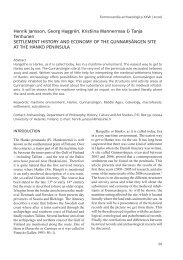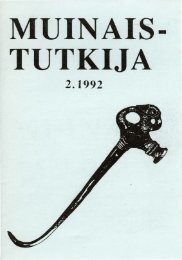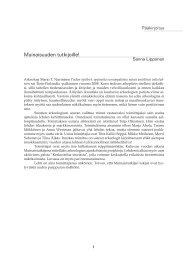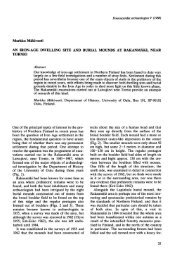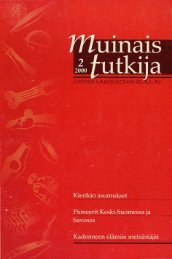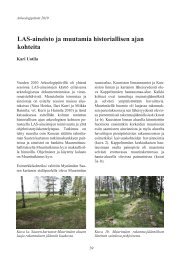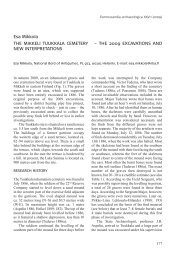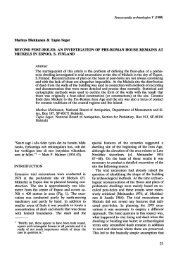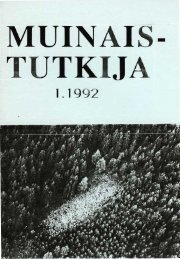Jari-Matti Kuusela MASTERS OF THE BURIAL GROUNDS â ELITES ...
Jari-Matti Kuusela MASTERS OF THE BURIAL GROUNDS â ELITES ...
Jari-Matti Kuusela MASTERS OF THE BURIAL GROUNDS â ELITES ...
You also want an ePaper? Increase the reach of your titles
YUMPU automatically turns print PDFs into web optimized ePapers that Google loves.
econstructed using the digital elevation model<br />
of the National Land Survey of Finland and the<br />
isostatic land uplift curves for the Vaasa region<br />
made by <strong>Jari</strong> Okkonen (2003).<br />
Looking at Figures 1a-d it is evident that the<br />
land uplift was a significant factor in the Iron Age<br />
landscape and it seems clear that the burials are<br />
closely related to the shores. In Figure 1d it can<br />
be observed that the Merovingian Period burials<br />
are centred on the shores of the long and narrow<br />
bay to where the Kyröjoki River flowed during<br />
this time. The Tervajoki group, now further to<br />
the inland than during the earlier periods, which<br />
has many prominent Migration Period burials,<br />
contains no burials form the Merovingian Period.<br />
This shore-boundedness has been explained as a<br />
dependency on shore meadows for grazing (Baudou<br />
1991). Thus this change could be explained<br />
by the fact that the Tervajoki area was no longer<br />
suitable for animal husbandry and this is why the<br />
area was abandoned.<br />
Other changes from the Migration Period to<br />
the Merovingian Period seem evident as well<br />
– there are more Migration Period sites than<br />
Merovingian Period sites and this has been interpreted<br />
as an indicator that the population of the<br />
Merovingian Period was smaller than that of the<br />
Migration Period (Ahtela 1981: 127; Seger 1982).<br />
This might also make sense remembering the importance<br />
of the shore meadows (see Holmblad &<br />
Herrgård 2005: 142, 151–3) – as the inland areas<br />
were no longer suitable for grazing, as the land<br />
rose, the people in the inland settlement areas had<br />
to seek better places to live in. This explanation<br />
is not unproblematic because it is deterministic<br />
and gives a too simple explanation for a complex<br />
phenomenon. This is especially true in the case of<br />
the Kyröjoki region because here the ecological<br />
changes caused by the land uplift were minimal<br />
(Holmblad & Herrgård 2005: 190–204). Another<br />
problem is once more the assumption that burials<br />
actually represent the whole society. Not claiming<br />
that the above explanation would be wrong, I<br />
argue that there is more to the story than the subsistence<br />
needs of humans. Therefore I will analyse<br />
the development of the Vähäkyrö area from the<br />
perspective of power structures and elites.<br />
Resources of legitimated power<br />
I have previously argued that during the Iron Age<br />
the social and power elite determined their status<br />
with two capitals – the honour and material capital<br />
(<strong>Kuusela</strong> 2008). Honour capital determined the<br />
social status of the agent and material capital<br />
functioned as a resource with which honour<br />
capital was maintained and generated. This means<br />
that material capital was meaningful only after it<br />
was used and turned into honour capital (<strong>Kuusela</strong><br />
2008: 27–8; see also Hedeager 1992). This could<br />
easily lead to the assumption that material capital<br />
is by itself a power resource but this would be<br />
a simplification. Material capital and honour<br />
capital form a part of the symbolic capital (e.g.,<br />
Bourdieu 1977: 171–83; 1989) of the Iron Age<br />
and it is the sources of this symbolic capital that<br />
form the resource of legitimated authority of<br />
the Iron Age. Symbolic capital is born from the<br />
interplay between honour and material capital<br />
and their exact role in the composition of the<br />
symbolic capital may change through time as I<br />
will argue later.<br />
In this paper I will focus especially on material<br />
capital with which I mean all material wealth<br />
such as cattle, land and moveable goods to name<br />
a few. Material wealth itself is not important,<br />
it is important only to the degree that it makes<br />
up the composition of the symbolic capital as a<br />
whole. Nevertheless it seems evident that material<br />
wealth has played an important part in the<br />
social distinction of the Iron Age and thus it has<br />
had an important part in the functioning and creation<br />
of power structures. Therefore I will, in this<br />
paper, use the concept of material capital to give<br />
a social explanation for the changes observable<br />
in Vähäkyrö during the Migration- and Merovingian<br />
Periods.<br />
Exchange and power<br />
If we accept that material capital has been an<br />
important factor in the Iron Age power structures<br />
we can simplify the structure by comparing it to<br />
an exchange (see Blau 1987 [1964]). Those who<br />
have access to a large amount of material capital<br />
(the power elite) can distribute it amongst those<br />
who are lacking it (the social elite) in exchange<br />
for compliance. This exchange has limits as the<br />
agent redistributing material capital has to maintain<br />
balance between distributing material capital<br />
and preserving a status where his material capital<br />
still exceeds the capital of other agents. As long<br />
as this balance is maintained, the power structure<br />
will remain stable and the exchange-cycle functions<br />
as a reproducing mechanism maintaining the<br />
46



